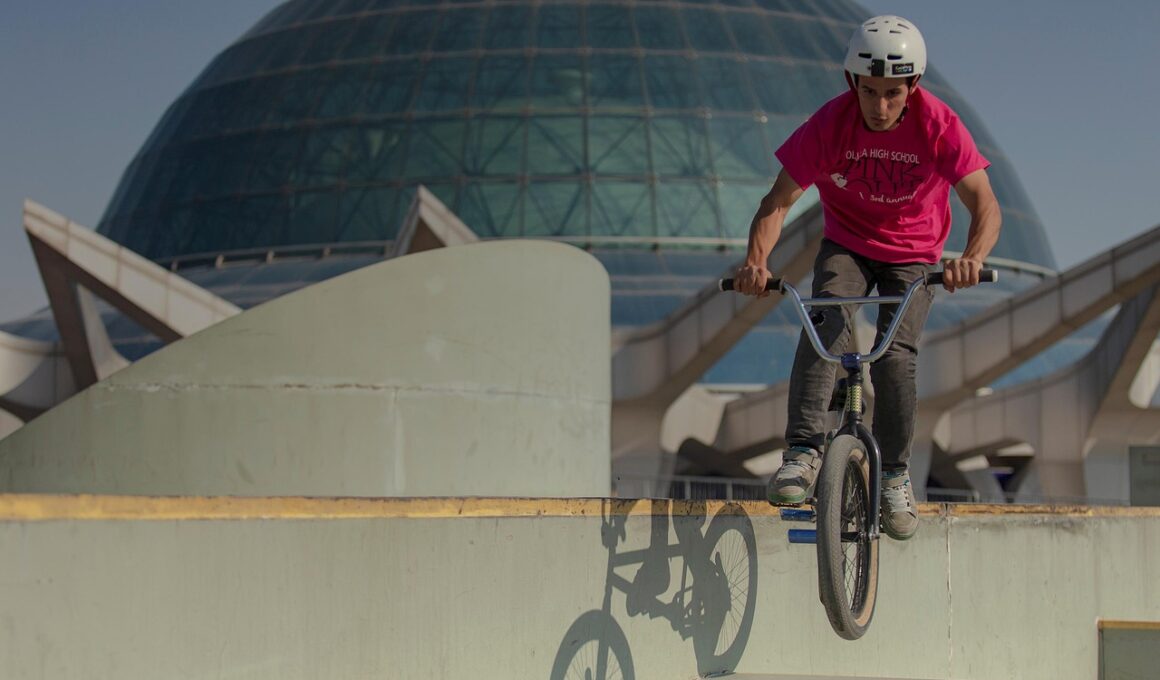How to Organize a BMX Event or Meetup
Organizing a BMX event or meetup can be challenging but rewarding. Start planning early to ensure everything runs smoothly. First, gather a team of passionate BMX riders to help you brainstorm ideas and logistics. Create a checklist to track essential tasks, including location, permits, and sponsorships. You may also need to determine an appropriate date that doesn’t conflict with other local events. One option is to choose a weekend when more riders are likely to be available. Once you finalize the date, secure a venue that can accommodate both the riders and spectators. Look for BMX parks, dirt tracks, or an open field. It’s vital to ensure the venue is safe and has adequate facilities for all participants. Don’t forget to discuss potential accessibility issues for riders with disabilities. Besides safety, consider providing food and drinks at the event, which can enhance the experience for attendees. Reach out to local food trucks or vendors who may want to join the event and attract more spectators. Being proactive in planning can set the stage for a successful BMX gathering.
Next, promoting your BMX event is crucial. Utilize social media platforms like Facebook, Instagram, and Twitter when sharing details. Create an event page that includes all relevant information such as date, time, and location. Encourage attendees to share the event with their networks to increase exposure. Collaborate with local BMX shops, clubs, and influencers for cross-promotion. They can assist in reaching a larger audience interested in BMX, ensuring a vibrant turnout. Consider designing eye-catching flyers and posters for local distribution. Place them in bicycle shops, schools, and community centers to attract attention. Additionally, engaging with community forums and online groups focused on BMX can amplify your reach. Make sure to invite local media and newspapers to cover the event. This can result in articles or announcements that can generate buzz. Always remember to maintain clear communication with all participants. Send out reminders as the event date approaches, and provide updates on any changes. Having a well-structured plan and strategy for promotion can significantly enhance your event’s success.
Logistics and Equipment
Logistical details are key to a successful BMX event. Prepare a list of necessary equipment you may need, including bikes, safety gear, and event supplies. Ensure all riders have helmets and pads, as safety is paramount in any sport. It may be beneficial to offer rental equipment for those who are just starting or do not own a bike. Having first-aid kits on-site must also be a priority, along with trained staff to handle any emergencies. Plan for the setup and breakdown of the event space, considering how long each aspect will take. Designate specific areas for registration, warm-up, and competition zones. Consider the flow of the event to avoid congestion and maximize rider safety. An appropriate sound system for announcements and music can create an engaging atmosphere. Additionally, consider planning some fun side activities, like raffles or BMX training workshops. These can appeal to a broader audience and attract more participants. Having adequate signage to guide attendees everywhere is crucial, so everyone knows where to go for each part of the event.
Financial management is another crucial aspect of organizing a BMX event. Budgeting ensures that you cover your expenses while maximizing any potential profit. Start by estimating costs and considering potential income sources, such as entry fees, sponsorships, and merchandise sales. It’s wise to set a fixed entry fee for participants, ensuring it is affordable while covering costs. On the sponsorship side, approach local businesses that support BMX or sports in general. They can provide funding in exchange for advertising opportunities at your event. Create sponsorship packets outlining the benefits they will receive. Additionally, consider selling event merchandise such as t-shirts, hats, or stickers to boost income. Keep track of all financial transactions carefully. An organized accounting method can prevent any financial discrepancies later on. Gathering feedback from participants afterward can also help assess whether ticket prices and merchandise were reasonable. This data can be invaluable for planning future events. Adjusting your budget based on past experiences can contribute to a more successful event next time.
Creating a Competitive Environment
Crafting a competitive atmosphere is essential for BMX events. Many riders thrive in environments where they can showcase their skills. Establish different categories or divisions, such as age groups or skill levels, to cater to a wide variety of participants. This approach allows everyone a chance to compete without feeling overwhelmed or outmatched. Events like street riding, dirt jumping, and flatland competitions can attract various BMX enthusiasts. Ensure there are reliable judges to evaluate the performances based on predetermined criteria. Publish the scoring system transparently so participants understand what to expect. In addition to competition, provide opportunities for riders to earn recognition. Awards for top finishers can be a substantial motivator, whether they are trophies, medals, or prizes. Hosting a best trick contest may introduce an element of fun and creativity to the event, allowing riders to express themselves. Incorporate spectator involvement to enhance excitement, encouraging cheers and support throughout the day. A competitive yet supportive atmosphere can elevate the BMX experience for everyone involved.
Engaging with the BMX community is vital both before and after the event. Building relationships with riders, their families, and supporters can create a welcoming environment. One effective way is by utilizing social media platforms to keep the conversation going. Post regular updates, encouragement, and behind-the-scenes content to create a sense of connection. Share photos and videos from the event afterward to highlight the excitement and memorable moments captured. Tagging participants in these posts can further enhance their sense of belonging within the community. Prompt feedback from attendees to improve future events. Consider creating a post-event survey to gauge the strengths and weaknesses. Understanding what worked well and what could be improved will empower you in future organizing efforts. Encourage participants to share their experiences on social media, which can ultimately help attract new riders to future events. Maintaining engagement keeps the spirit alive and encourages ongoing participation in BMX activities. By fostering a culture of support, you can help the local BMX scene flourish and create a lasting impact.
Following Up and Impact Assessment
Post-event follow-up is a critical step that can lead to meaningful improvements in any future BMX events. First, gather feedback from various stakeholders including riders, sponsors, and volunteers. Analyzing this feedback helps identify areas of success and those needing improvement. Consider sending thank-you emails to participants and sponsors, expressing gratitude for their support. This gesture fosters goodwill and encourages participation in future events. Document lessons learned during the planning and execution phases. Such reflections can help streamline the process for future BMX events. Maintain ongoing communication with the local BMX community through social platforms. Regular updates keep everyone informed and engaged between events. Highlight successes or announcements to showcase the vibrant community. Set up a dedicated platform or forum for discussions and ideas within the BMX community. These actions contribute to a stronger BMX scene, ensuring its sustainability. Continuous impact assessment can inform future event planning, ultimately leading to enhanced experiences for participants and audience alike. Ultimately, an inclusive approach, where every rider feels valued, can contribute significantly to the sport’s growth.
In conclusion, organizing a BMX event requires detailed planning, promotion, and community engagement. From logistics to creating a competitive atmosphere, every step is crucial. By fostering connections within the BMX community, promoting inclusivity, and encouraging diverse participants, you can enhance the overall experience for everyone. Additionally, utilizing effective communication tools for updates, feedback, and social engagement should be the role of any organizer. Ensuring safety and accessibility makes a significant difference in providing equal opportunities for all riders. Mapping a budget and keeping track of finances allows for sustainable event management. Most importantly, maintain enthusiasm and energy throughout, engaging not just participants but also spectators. Support from local businesses and riders creates a lasting impact that resonates beyond the event itself. Collaboration with various groups in the community can provide additional resources and exposure. Most importantly, continue fostering positive relationships, not just for this event, but for the continuation of the BMX culture. An impactful event can motivate riders to commit to the sport and help grow the BMX scene in your locality. Through strategic planning and passionate execution, your BMX event can leave a legacy.


